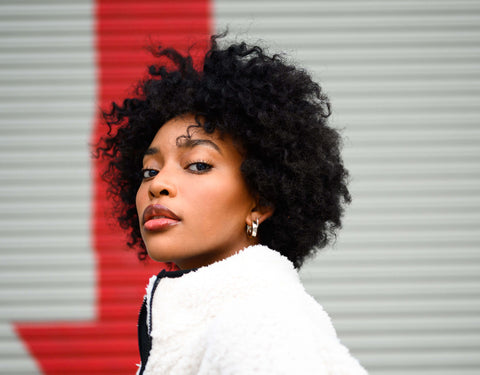When you begin the journey of transitioning to natural hair, quick resets like big chops promise a head start to make the process move faster.
A full reset might be the right first step for you and your hair, but the less abrupt path of transitioning to natural hair with protective styles, braids, and transition hair-friendly formulas can often be the most beautiful one.
No matter which way you go, the best first move is always to understand what to be prepared for.
The Stages of Transitioning to Natural Hair
Stage 1: The Beginning of Bloom
We usually consider the first three months as phase one of your hair’s transition, and it’s when you’ll begin to see noticeable signs of newly sprouted, healthy strands (if you’re taking the right steps to keep hair healthy, but we’ll get to that in a moment)
New strands may grow up to three or four inches during the first phase, and original strands may elongate by just as much. We call phase one the Beginning of Bloom, because the true potential of your natural locks will begin coming to light.
Stage 2: Follicles Find Their Form
After the first few months, you may see growth begin to plateau, but you’ll also start seeing your hair’s new textures and patterns begin to take shape. It’s possible you’ll see multiple patterns. After all, textured hair is beautifully multidimensional, but that’s perfectly normal.
So if you’re seeing a mix of tight tendrils alongside wavier, looser locks, don’t worry – it’s all a part of the blooming process.
Stage two usually lasts through month six or seven of your hair’s transition.
Stage 3: Multidimensional Growth
Stage 3 encompasses the remainder of your first year transitioning from treated to natural hair, and it’s during this phase that your hair’s new pattern – or patterns – will start to solidify. This can be a difficult stage, and it can be the most awkward as strands continue to bloom and take shape at varying times.
There’s still no reason to worry, it just means your locks may need a little extra love during this stage. Double down on your leave-in conditioners and oils to keep strands hydrated, healthy, and lifted as they find their form.
Stage 4: The Sky is the Limit
Now the fullness of your natural hair begins to come to life, and as its new patterns will now be in full form, you and your hair can really start getting acquainted. Stage 4 spans the remainder of your journey after the first year, and now the sky is the limit.
Just like in stage 3 (and really, beginning from day one) nourishing and moisturizing is the best way to keep giving your natural locks endless love. The products you’ll want to use when transitioning to natural hair will vary by your hair type, but for most textured hair, keep reaching for your leave-ins and oils, while also intentionally selecting a rich shampoo and rinsing conditioner that specializes in helping locks retain moisture, not just absorb it.
Our best tip? You should never be too far from a hydrating mist or essence anytime during your first year. These are strand-savers when it comes to giving hair a quick spritz of heavy hydration anywhere you go.
Styles we Love for Transitioning Natural Hair
We know the journey to natural can hit a few kinks, and some stages might have you feeling a little vulnerable about letting your new locks flow. In those moments, protective styles can be your best friend for getting through the snags of transitioning hair.
Box Braids
You can never go wrong with a classic. Perfect for long strands transitioning from chemically-treated, box braids keep hair protected from sun, harsh water, and other environmental challenges while still preserving its bloom.
Curly Cornrows
A slight deviation from standard cornrows, this is one of our favorite styles when transitioning to natural hair. Prep hair before style with an enduring leave-in conditioner for long-lasting hydration, and treat daily with a scalp or blooming serum to encourage strands to continue their journey.
Two-Strand Twists
Our must-do for hair that’s beginning it’s journey with shorter strands, two-strand twists require less length, but still help shield hair from environmental damage. Keep your favorite hydrating essence close by, as it’s easy to give these twists a quick mist if they begin to show dryness or frizz.
The road to natural hair isn’t always a straight line, but through all the twists, turns, zigs, zags, winds and bends – your fullest life with your fullest hair awaits.


